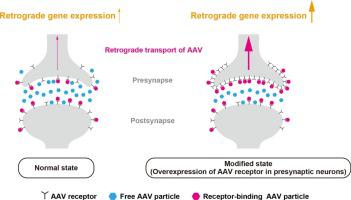Journal of Neuroscience Methods ( IF 2.7 ) Pub Date : 2020-07-30 , DOI: 10.1016/j.jneumeth.2020.108887 Hiromi Sano 1 , Kenta Kobayashi 2 , Nozomu Yoshioka 3 , Hirohide Takebayashi 3 , Atsushi Nambu 4

|
Background
Viral vector systems delivering transgenes in the retrograde direction through axons to neural cell bodies are powerful experimental tools for the functional analysis of specific neural pathways. Generally, the efficiency of viral vector-mediated retrograde gene transfer depends on the expression of requisite viral receptors in neural pathways projecting to the viral vector-injected regions. This is known as viral tropism and can limit the utility of retrograde viral vectors. The adeno-associated virus (AAV) vector has become an increasingly popular platform for gene delivery to neural cells in vivo, and it is therefore meaningful to develop a new type of retrograde gene transfer approach based on a tropism-free AAV vector system.
New Method
The wild-type or mutant receptor gene of AAV was expressed to mitigate AAV tropism.
Results
Efficient AAV vector-mediated retrograde gene transfer was observed in diverse neural pathways by expression of the AAV receptor (AAVR) gene. Moreover, the expression of a minimal mutant of AAVR (miniAAVR), which maintains binding potential to AAV, demonstrated efficient retrograde gene expression comparable to that of AAVR.
Comparison with Existing Methods
The utility of existing AAV vector-mediated retrograde gene delivery methods is sometimes limited by tropism. Our newly developed AAV-AAVR and AAV-miniAAVR interaction approaches enabled efficient retrograde gene transfer into various neural pathways by mitigating tropism.
Conclusions
AAV-AAVR and AAV-miniAAVR interaction approaches enabled us to induce efficient retrograde gene expression in targeted neural pathways and provide a powerful tool for analyzing specific neural pathways.
中文翻译:

逆行基因转移到由腺相关病毒(AAV)-AAV受体相互作用介导的神经通路中。
背景
病毒载体系统通过轴突将逆转基因传递到神经细胞体,是用于特定神经途径功能分析的强大实验工具。通常,病毒载体介导的逆行基因转移的效率取决于投射到病毒载体注射区的神经途径中必需病毒受体的表达。这被称为病毒嗜性,并且可能限制逆行病毒载体的效用。腺相关病毒(AAV)载体已成为在体内向神经细胞传递基因的日益流行的平台,因此,开发一种基于无向性的AAV载体系统的新型逆行基因转移方法具有重要意义。
新方法
表达了AAV的野生型或突变受体基因以减轻AAV的向性。
结果
通过表达AAV受体(AAVR)基因,在多种神经途径中观察到了有效的AAV载体介导的逆行基因转移。此外,维持与AAV结合潜力的AAVR最小突变体(miniAAVR)的表达证明了与AVR相当的有效逆行基因表达。
与现有方法的比较
现有的AAV载体介导的逆行基因传递方法的实用性有时会受到向性的限制。我们新开发的AAV-AAVR和AAV-miniAAVR相互作用方法可通过缓解嗜性使基因高效逆行转移到各种神经途径。
结论
AAV-AAVR和AAV-miniAAVR相互作用方法使我们能够在靶向神经通路中诱导有效的逆行基因表达,并为分析特定的神经通路提供了强大的工具。











































 京公网安备 11010802027423号
京公网安备 11010802027423号